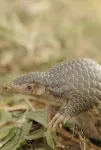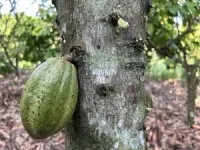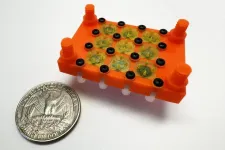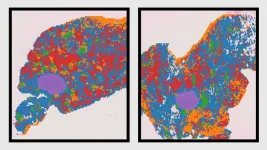(Press-News.org) Pangolins are unique as they are the only mammal to be covered in scales. Even though they are scaly, photos of them are typically met with “awwws” from the viewers who find them adorable. Importantly, though, pangolins play an essential role in maintaining their ecosystem. Their other “unique trait” is that they are the most trafficked wild animal in the world, with more than 900,000 poached in the past two decades. Much of this is due to their high value for use in traditional medicine that requires the use of pangolin meat and scales. This has pushed many pangolin species to the brink of extinction. In particular, two pangolin species, the Malayan pangolin (Manis javanica) and the Chinese pangolin (Manis pentadactyla), are under acute survival pressure. These species have been listed as critically endangered on the Red List of the International Union for Conservation of Nature (IUCN) since 2014.
With World Pangolin Day being celebrated on February 15, it is befitting that new research presenting high quality genomic data for these Pangolin species puts a spotlight on the genetic vulnerabilities and extinction risks for Malayan and Chinese pangolin species. This work is a collaborative effort of Chinese scientists involving Yan Hua’s team from the Pangolin Conservation Research Center of the National Forestry and Grassland Administration, Tianming Lan’s team from Northeast Forestry University, and Qiye Li at BGI-Shenzhen. The study has been published in the Open Science journal GigaScience.
The starting point for their analyses was generating genome sequences of the Chinese and Malayan pangolin species at a significantly higher resolution than what is currently available. Having such high quality data in the form of a nearly gapless chromosome-scale sequence is invaluable for obtaining essential information that are important indicators of genetic health and risk of extinction for any population. For this, the analyses carried out included genetic diversity estimates, which indicates how much genetic variation there is between individuals in a population. The greater the variation, the more genetically healthy future generations can be. Similarly, other parameters, such as the level of inbreeding within a population can be assessed and indicate the likelihood of there being major health issues inherited over time. These analyses can aid in focusing on the best ways to carry out rescue operations, such as whether selective breeding is essential.
The Chinese scientists used their high quality data as a reference point, along with previously released genomic data from 37 Chinese pangolin and 72 Malayan pangolin individuals, to re-evaluate the conservation genetic status of five pangolin populations. They found that the overall genetic diversity was surprisingly high— which is a positive sign for the genetic health of a population; but, their fine-grained analysis showed that some of these populations are at higher risk of extinction than the others.
Specifically, based on the genetic data for one Pangolin population, the scientists ascertained that this population had suffered a much faster and sharper population decline within the past 10,000 years compared with the other populations in their study. Additionally, other genetic parameters in their study indicated this population in particular was at a very high risk extinction. Adding to this, their analysis of a pangolin specimen from Taiwan revealed similarly distressing data. Future work is required to solidify the extent to which specific pangolin populations are at extinction risk due to serious survival pressures. The research data also indicate that further studies on the differences between the localities of these populations should receive more attention as they have the ability to aid in guiding the genetic rescue efforts that are already underway.
Professor Tianming Lan says: “In addition to aiding the management of illegal poaching and trafficking, the Chinese government has built a breeding center for the conservation of both Chinese and Malayan pangolins and has developed an artificial breeding and reproduction program. With the assistance of this data, we can better evaluate the genetic rescue strategies for wild populations by rewilding and releasing these captive individuals in the future.”
Read More:
Lan T; Tian Y; Shi M; Liu B; Lin Y; Xia Y; Ma Y; Kumar SS; Wang Q; Li J; Chen J; Hou F; Yin C; Wang K; Fu Y; Que T; Liu W; Liu H; Li H; Hua Y. Enhancing inbreeding estimation and global conservation insights through chromosome-level assemblies of the Chinese and Malayan pangolin. GigaScience. 2025. DOI:10.1093/gigascience/giaf003
Media contacts:
GigaScience, Editor-in-Chief:
Scott Edmunds, email: Scott@gigasciencejournal.com, Cell: +852 92490853
Expert:
Prof Tianming Lan, email: lantianming@nefu.edu.cn
Sharing on social media?
Find GigaScience online on BlueSky: @gigascience.bsky.social, X/twitter: @GigaScience, @GigabyteJournal, @Giga_DB; Facebook https://www.facebook.com/GigaScience, and keep up-to-date with our blog http://gigasciencejournal.com/blog
About GigaScience
GigaScience is co-published by GigaScience Press and Oxford University Press. Winner of the 2018 PROSE award for Innovation in Journal Publishing (Multidisciplinary), the journal covers research that uses or produces 'big data' from the full spectrum of the biological and biomedical sciences. It also serves as a forum for discussing the difficulties of and unique needs for handling large-scale data from all areas of the life and medical sciences. The journal has a completely novel publication format -- one that integrates manuscript publication with complete data hosting, and analyses tool incorporation. To encourage transparent reporting of scientific research as well as enable future access and analyses, it is a requirement of manuscript submission to GigaScience that all supporting data and source code be made available in the GigaScience database, GigaDB, as well as in publicly available repositories. GigaScience will provide users access to associated online tools and workflows, and has integrated a data analysis platform, maximizing the potential utility and re-use of data.
About GigaScience Press
GigaScience Press is BGI's Open Access Publishing division, which publishes scientific journals and data. Its publishing projects are carried out with international publishing partners and infrastructure providers, including Oxford University Press and River Valley Technologies. It currently publishes two award-winning data-centric journals: its premier journal GigaScience (launched in 2012), which won the 2018 American Publishers PROSE award for innovation in journal publishing, and its new journal GigaByte (launched 2020), which won the 2022 ALPSP Award for Innovation in Publishing. The press also publishes data, software, and other research objects via its GigaDB.org database. To encourage transparent reporting of scientific research and to enable future access and analyses, it is a requirement of manuscript submission to all GigaScience Press journals that all supporting data and source code be made openly available in GigaDB or in a community approved, publicly available repository. Curating 3D data the GigaDB team also make this data usable by the 3D printing community in Thingiverse (see https://www.youtube.com/watch?v=EHSbeDFN_k8).
END
World Pangolin Day celebrated with new genomes to aid the world’s most trafficked animal
Marking World Pangolin Day (February 15th) with new research highlighting pangolin populations that are at risk of extinction with new high-quality reference genome sequences and an in-depth genomic analyses from two different species
2025-02-14
ELSE PRESS RELEASES FROM THIS DATE:
Dangerous bacteria lurk in hospital sink drains, despite rigorous cleaning
2025-02-14
We hope to be cured when we stay in hospital. But too often, we acquire new infections there. Such ‘healthcare-associated infections’ (HAI) are a growing problem worldwide, taking up an estimated 6% of global hospital budgets. In the EU alone, HAIs add up to more than 3.5 million cases per year, resulting in 2.5 million disability-adjusted life years, a cost of up to €24 billion, and 90,000 deaths. They are likewise the sixth leading cause of death in the US.
Patients with lowered immune defenses, and in some hospitals, ...
Mini flow battery speeds energy storage research
2025-02-14
RICHLAND, Wash.—Sometimes, in order to go big, you first have to go small. That’s what researchers at the Department of Energy’s Pacific Northwest National Laboratory have done with their latest innovation in energy storage.
With a goal to speed the time to discovery of new grid energy storage technology, the team designed a compact, high-efficiency flow battery test system that requires an order of magnitude less starting material while delivering results equal to the standard lab-scale ...
Graphite production gets a makeover
2025-02-14
Collaboration efforts between the Texas A&M University Artie McFerrin Department of Chemical Engineering and the U.S. Department of Energy Advanced Research Projects Agency-Energy (ARPA-E) have led to innovative research on how petroleum coke is processed.
This almost $3 million three-year research project will convert petroleum coke to graphite for energy storage. The newer process uses a lower temperature and shorter time to produce graphite from petroleum coke.
This new catalytic graphitization technology will ...
Ancient Egyptian mummified bodies smell ‘woody,’ ‘spicy’ and ‘sweet’
2025-02-14
UCL Press Release
Under embargo until Friday 14 February 2025, 00:01 UK time / 19:01 Thursday 13 February US Eastern time
Ancient Egyptian mummified bodies smell ‘woody,’ ‘spicy’ and ‘sweet’, finds a new study led by researchers from UCL and the University of Ljubljana, revealing new details about mumification practices.
The research, published in Journal of the American Chemical Society, is the first time that the smells of mummified bodies have been systematically studied combining a mix of instrumental and sensory techniques, including an electronic ‘nose’ ...
MIT engineers develop a fully 3D-printed electrospray engine
2025-02-13
CAMBRIDGE, MA – An electrospray engine applies an electric field to a conductive liquid, generating a high-speed jet of tiny droplets that can propel a spacecraft. These miniature engines are ideal for small satellites called CubeSats that are often used in academic research.
Since electrospray engines utilize propellant more efficiently than the powerful, chemical rockets used on the launchpad, they are better suited for precise, in-orbit maneuvers. The thrust generated by an electrospray emitter is tiny, so electrospray engines typically use an array of emitters that are uniformly ...
Speculum exams unnecessary for HPV screening
2025-02-13
Genital human papillomavirus is the most common sexually transmitted infection in the United States and is thought to be responsible for more than 99% of cervical cancers.
HPV screening usually entails a speculum-based exam, which is an uncomfortable experience for most patients, especially those who have physical disabilities.
In two studies, published in Preventive Medicine Reports and JAMA Network Open, University of Michigan researchers are the first to demonstrate in the U.S. that self-sampling is just as effective as speculum-based testing for HPV detection.
Most people who have HPV are usually unaware that they have it.
By ...
Reduced prediabetes in people who ate broccoli compound
2025-02-13
The chemical compound sulforaphane found in broccoli sprouts can be linked to improved blood sugar levels in prediabetes, a precursor to type 2 diabetes. This has been shown in a study conducted at the University of Gothenburg. The broccoli compound had a more significant effect on blood sugar levels in certain people.
Researchers at the University of Gothenburg have previously identified sulforaphane as an antidiabetic agent in type 2 diabetes. A patient study conducted in 2017 demonstrated significantly lower blood sugar in people with diabetes after they took large ...
Landmark atlas reveals how aging breast tissue shapes breast cancer risk
2025-02-13
Aging is a privilege, but it also brings risks—including an increased likelihood of developing age-related diseases including cancer. Researchers at The Jackson Laboratory (JAX) have created a landmark atlas of how healthy breast tissue ages, revealing key cellular, molecular, and genetic changes that may tip the balance toward breast cancer development. Their findings, published recently in Nature Aging, provide a valuable open-access resource for the scientific community to explore aging and its role in increased cancer risk.
Rewriting ...
SHEA supports key federal advisory committees
2025-02-13
The Society for Healthcare Epidemiology of America (SHEA) urges incoming Secretary of the U.S. Department of Health and Human Services, Robert F. Kennedy Jr., to resume the federal advisory committees for key health-related priority issues as provided under the Federal Advisory Committees Act. Federal advisory committees are an important aspect of the deliberative process for reviewing important scientific information among federal agencies and members of the public as new evidence becomes available. The ability for members ...
Neurologic complications of flu nearly 50 times greater for children with underlying neurologic conditions
2025-02-13
Many clinicians do not consider neurologic complications of the flu when discussing vaccination or treatment of influenza with families.
A recent study that explored the neurologic impact of flu in children aims to change that.
“Serious Neurologic Events with Seasonal Influenza in Young Children,” published in Academic Pediatrics, the official journal of the Academic Pediatric Association, looked at the population-based incidence of underrecognized influenza-associated serious neurologic events in children less than 5 years of age.
While serious neurologic complications are uncommon in young children, the study showed a much higher incidence, ...
LAST 30 PRESS RELEASES:
Making lighter work of calculating fluid and heat flow
Normalizing blood sugar can halve heart attack risk
Lowering blood sugar cuts heart attack risk in people with prediabetes
Study links genetic variants to risk of blinding eye disease in premature infants
Non-opioid ‘pain sponge’ therapy halts cartilage degeneration and relieves chronic pain
AI can pick up cultural values by mimicking how kids learn
China’s ecological redlines offer fast track to 30 x 30 global conservation goal
Invisible indoor threats: emerging household contaminants and their growing risks to human health
Adding antibody treatment to chemo boosts outcomes for children with rare cancer
Germline pathogenic variants among women without a history of breast cancer
Tanning beds triple melanoma risk, potentially causing broad DNA damage
Unique bond identified as key to viral infection speed
Indoor tanning makes youthful skin much older on a genetic level
Mouse model sheds new light on the causes and potential solutions to human GI problems linked to muscular dystrophy
The Journal of Nuclear Medicine ahead-of-print tip sheet: December 12, 2025
Smarter tools for peering into the microscopic world
Applications open for funding to conduct research in the Kinsey Institute archives
Global measure underestimates the severity of food insecurity
Child survivors of critical illness are missing out on timely follow up care
Risk-based vs annual breast cancer screening / the WISDOM randomized clinical trial
University of Toronto launches Electric Vehicle Innovation Ontario to accelerate advanced EV technologies and build Canada’s innovation advantage
Early relapse predicts poor outcomes in aggressive blood cancer
American College of Lifestyle Medicine applauds two CMS models aligned with lifestyle medicine practice and reimbursement
Clinical trial finds cannabis use not a barrier to quitting nicotine vaping
Supplemental nutrition assistance program policies and food insecurity
Switching immune cells to “night mode” could limit damage after a heart attack, study suggests
URI-based Global RIghts Project report spotlights continued troubling trends in worldwide inhumane treatment
Neutrophils are less aggressive at night, explaining why nighttime heart attacks cause less damage than daytime events
Menopausal hormone therapy may not pose breast cancer risk for women with BRCA mutations
Mobile health tool may improve quality of life for adolescent and young adult breast cancer survivors
[Press-News.org] World Pangolin Day celebrated with new genomes to aid the world’s most trafficked animalMarking World Pangolin Day (February 15th) with new research highlighting pangolin populations that are at risk of extinction with new high-quality reference genome sequences and an in-depth genomic analyses from two different species








